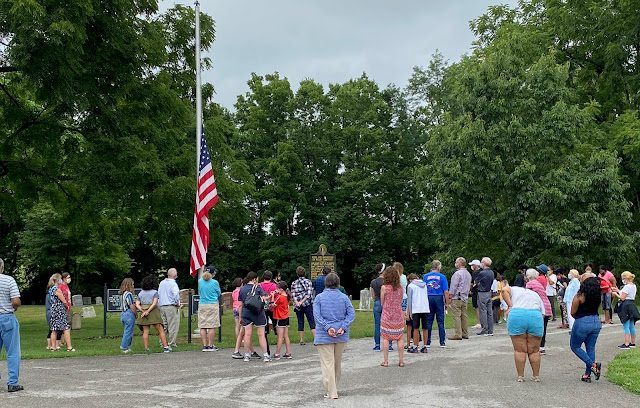 |
| Marchers, wearing masks, gathered at the Sons and Daughters of Relief Cemetery. (Photo by Aaron Gershon; to enlarge, click on it) |
University of Kentucky School of Journalism and Media
On an overcast day when rain threatened but temperatures were cooler than usual, 50 people marched through Midway to honor those affected by the July 31, 1868 attack on the Second Christian Church.
Friday's event was organized by Honoring Black Stories in Midway, a group dedicated to African American history in the city.
“In Midway, much work has been done regarding researching our Black history, but many people are unaware,” event organizer Milan Bush told the Messenger. She said the march was for awareness and to celebrate the resilience of African Americans since slavery.
Mayor Grayson Vandegrift said, “I think this was a very important event for our city to remember when we’re talking about our history. We have to talk about it from many perspectives.”
 |
| Second Christian Church faces Smith Street. (Photo by Aaron Gershon) |
“We have to acknowledge the good and the bad,” Vandegrift said. “And the more I talk to Black citizens around town, the more I realize many simply want their story to be told too, and it’s most important they be the ones to tell it. And we listen.”
The march began at City Hall, went to Second Christian Church at Smith and Stephens streets, and then 0.6 miles across town to the Sons and Daughters of Relief Cemetery at the west end of Bruen Street, where many African Americans are buried.
Vandegrift walked and was pleased with the turnout. “I thought it turned out great, even better than I expected,” he said. “Over 50 people, more than 90 percent Midway residents, both white and black.”
Midway writer Bob Rouse posted on his blog, "Of a Midway Mind," to share his experience in the march.
“In my 62 years, I have walked for miles on Midway’s streets and sidewalks: on Halloween nights with my family, during growing-up days with my friends, and on moonlit evenings with a sweetheart,” Rouse wrote. “But today I walked with purpose in my heart. I walked in the spirit of peace—as John Lewis implored—with my sisters and brothers.”
U.S. Rep. John Lewis, D-Georgia, who was the last living civil-rights leader who spoke at the 1963 March on Washington, died July 17 and was buried Thursday in Atlanta.
Perhaps the lone concern about holding the event was having a gathering of more than 10 people in the midst of the covid-19 pandemic, contrary to an order from Gov. Andy Beshear. Every marcher was wearing a mask and generally kept distance from each other.
“We live in a special community, which we knew, ” Vandegrift said. “But today showed another loving face of our city.”

1 comment:
There's a little more to the story about the church and the Freedmen's School that held classes there. The "Log Church" began holding services around 1842. It was the beginning of the Midway Second Christian Church even though it did not use that name in 1842. The Disciples of Christ had a policy about calling any black church "Second." The attack on the school happened 26 years later in 1868. According to Racial Violence in Kentucky, an attack on the church by a mob proceeded to "wreck the church, destroying the pews and shooting out the windows. Several people were injured by the many rounds of ammunition fired by the irate whites." The attack and ransacking was at night. But there is no mention of burning the church. J. W. Alvord was tasked with writing a report about Freedmen's schools to reconstruction authorities every 6 months and reflected that there was intense Ku Klux Klan activity in neighboring Fayette and Madison counties at the time, but that group wasn't specifically named in the church incident. Alford also describes the dimensions of the Midway school as being 20 feet by 30 feet. The next year a Midway landowner named A. M. Hayden died, and his widow was forced to sell off a subdivision of house lots to satisfy his debts. Many of them were bought by recently enslaved African Americans and that area became know as "Haydenville." Soon after that the Midway City Council, concerned that the African residents of Haydenville would demand to vote in coming elections, voted to exclude that area from the city limits to prevent them. Haydenville began at the intersection of Smith and Stephens Streets and extended south and west to Winter Street.
Post a Comment